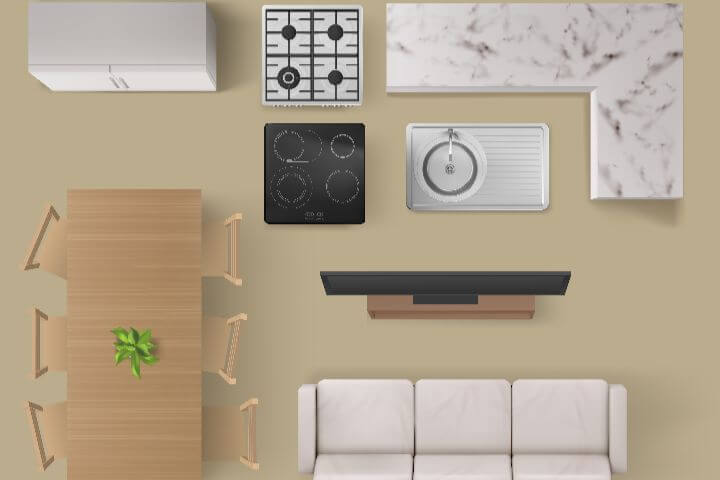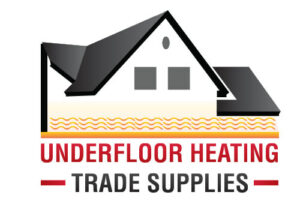Can you put furniture on underfloor heating? It’s a common question for homeowners looking to install this efficient underfloor heating system. The short answer is yes, but there are important considerations to keep in mind.
Furniture placement can affect how well your system performs, as well as the longevity of both your flooring and furniture. In this guide, we’ll explain the challenges, what to avoid, what works best, and how to make smart choices to get the most out of your system.
Key points:
- Most furniture can be used with underfloor heating if positioned correctly.
- Heavy, flat-bottomed items can block heat and reduce efficiency.
- Clearance of at least 3–5 cm under furniture allows proper airflow.
- Certain materials (wood, leather) may warp or dry out above 27°C.
- Using furniture with legs or breathable rugs helps maintain performance.
Challenges of Placing Furniture On Underfloor Heating
Placing furniture on top of underfloor heating can create a few practical challenges. The main issue is heat flow. If heat cannot rise evenly through the floor, you may find cold spots in your room, wasted energy, or even damage to flooring and furniture.
According to Hannah Healey at Which?, floor coverings must have relatively low thermal resistance to allow the system to perform properly. The same applies to furniture – solid bases can act as barriers.
- Average heat output of underfloor heating: 65–100 W/m², depending on insulation and floor type.
- Blocking just 15–25% of the heated floor area with heavy furniture can reduce efficiency by up to 30%.
Heavy sofas, beds, or wardrobes placed directly on the floor without clearance can trap heat. This not only wastes energy but can create hotspots that risk damaging pipes or heating mats beneath.
What to Avoid
Some furniture types and coverings are less suitable for use directly above underfloor heating:
- Flat-bottomed furniture: Cabinets, wardrobes, or bookcases with no legs can trap heat, potentially causing overheating.
- Insulating rugs: Thick or felt-backed rugs act like insulation, preventing heat transfer.
- Permanent fixtures: Heating elements should never be installed under fixed items, such as kitchen units, refrigerators, or built-in wardrobes.
- Overstuffed sofas or beds with no airflow: These can reduce heat distribution and trap warm air beneath.
What to Use Instead
Luckily, you don’t have to compromise; there are plenty of ways to make furniture compatible with underfloor heating:
- Furniture with legs: Items like sofas, chairs, and tables with legs create gaps that allow heat to circulate.
- Bun feet or risers: Adding these to heavier pieces can provide 3–5 cm clearance.
- Caster cups or plates: These distribute weight evenly, protecting the flooring while maintaining air circulation.
- Low-thermal-resistance rugs: Hessian or woven rugs are safer choices than thick carpets.
This approach not only protects your system but also improves household efficiency. Research by the Housing Analysis Team on the Energy efficiency of housing in England and Wales shows that most homes fall into Band D, and improving heating efficiency can significantly reduce energy bills. Underfloor heating combined with correct furniture placement helps households perform closer to Band C or better.
Interested in maximising your heating efficiency? Browse our water underfloor heating kits designed to improve every household’s heating efficiency – able to be installed beneath all floor types.
Heat Output and Furniture Impact

The way heat spreads through your floor depends on how much of the surface is exposed. Covering large areas with immovable furniture reduces circulation and results in higher energy consumption. Heat output ranges 65 to 100 W/m² depending on the floor type. If 20% of the floor area is blocked, usable output can drop by around 30%.
Furniture Coverage vs. Efficiency Loss
| % Floor Area Blocked | Estimated Efficiency Loss |
| 10% | 10–12% |
| 20% | 25–30% |
| 30% | 40%+ |
This highlights why positioning furniture carefully matters. Even shifting a large sofa a few centimetres can make a difference to how evenly heat circulates.
Safe Materials and Temperature Tolerance
Most furniture is safe with underfloor heating when used correctly, but some materials are more sensitive to heat than others.
- Wood: Solid wood can warp if the floor temperature exceeds 27°C. Engineered wood handles heat better.
- Leather: Prolonged exposure to warm air may dry or crack leather. Ensure circulation and avoid direct hotspots.
- Metal and glass: These materials conduct heat well and pose no issues.
- Foam and plastics: Some cheaper plastics or foams may soften if exposed to long-term heat build-up.
The BS EN 1264 standard for underfloor heating sets 27°C as the safe maximum floor surface temperature. Staying within this ensures furniture remains undamaged and your system operates efficiently.
Furniture Layout Tips for Efficiency

Getting the most from your underfloor heating system is as much about the layout as it is about the system itself. This can differ room to room, read our guide on underfloor heating in bedrooms.
Practical tips:
- Leave at least a 10 cm gap between walls and large furniture to allow airflow.
- Use legs or risers to provide 3–5 cm clearance under sofas, beds, and units.
- Avoid placing items, such as mattresses, directly on the floor – always use a bed frame with slats.
- Consider lighter, movable furniture to allow flexibility in heating patterns.
- Use breathable rugs and avoid placing them directly over heating pipes or mats.
By following these guidelines, you’ll ensure your underfloor heating works evenly across the space, reducing cold spots, lower temperature and energy waste.
Rugs, Carpets, and Furniture
Floor coverings make just as much difference as furniture. For example, thick carpets can restrict heat transfer in the same way a flat-bottomed wardrobe does. So, before you question “can you put furniture on underfloor heating?”, consider the best flooring for underfloor heating as well.
The key is to maintain low thermal resistance, whether it’s flooring, furniture, or accessories. Doing so protects your investment and ensures your home feels warm and comfortable throughout the year.
Learn which options are best for combining soft flooring with efficient heating: carpet underfloor heating.
Can You Put Furniture On Underfloor Heating?
So, can you put furniture on underfloor heating? Yes, but the way you place it makes all the difference. Avoid heavy, flat-bottomed items and provide clearance for airflow. Choose materials that tolerate gentle warmth. By doing this, your system will heat rooms evenly, protect your furniture, and reduce energy costs. Underfloor heating isn’t just about comfort; it’s also about long-term efficiency, especially when paired with smart furniture choices.
FAQs
Can you put a sofa on top of underfloor heating?
Yes, you can put a sofa on underfloor heating, but it should have legs to allow airflow underneath. Avoid flat-bottomed sofas as they can trap heat and reduce efficiency.
Can you put furniture on heated floors?
Most furniture is safe on heated floors as long as it allows heat to circulate. Choose items with legs or risers, and avoid blocking large areas with heavy, solid pieces.
Can you put a bed on top of underfloor heating?
You can place a bed on top of underfloor heating, but the bed frame should have slats or legs to provide clearance and prevent trapping heat, which can affect system performance.
Can I put a fridge on top of underfloor heating?
It’s not recommended to put fridges, freezers, or other permanent fixtures on the underfloor heating. They block heat, create hotspots, and may cause long-term damage to the system.
Sources
Hannah Healey (2025) Underfloor heating pros and cons. https://www.which.co.uk/. Available at: https://www.which.co.uk/reviews/underfloor-heating-systems/article/underfloor-heating-pros-and-cons-a8GBb3u9pXxj [16.09.2025]Housing Analysis Team (2024) Energy efficiency of housing in England and Wales: 2024. https://www.ons.gov.uk/. Available at: https://www.ons.gov.uk/peoplepopulationandcommunity/housing/articles/energyefficiencyofhousinginenglandandwales/2024 [16.09.2025]
